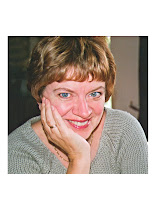
Vampires are still with us -"Bitelit" as Jane Churchill called it in the Bookseller (should that be "bitlit" Jane, or is it all the anticipation?). I saw a book called Swoon, on the Simon & Schuster stand, which says it all about the Meyer effect.
But the word among scouts and film agents was that they were all vampired out; even werewolves are a bit passé. That's the trouble with fairs; they show you what's there and what will come out soon but that is often very like what has just been successfully published.
So we saw lots of princesses, pirates, mermaids, ghosts, dragons and fairies - and girl gangs. Or teams, as publishers prefer to call them. The first person we met at the Fair on Monday was a pretty dark-haired young woman in a red vaguely medieval outfit, handing out dagger-shaped bookmarks to publicise a book called Graceling by Kristin Cashore. She was soon joined by a Daniel Radcliffe lookalike in a black velvet cloak and a knight in armour.
Published by Harcourt in the US last year and this year by Orion in the UK, Graceling is Cashore's first book and the first in a series about characters who all have a special gift. This heroine's one is that she has been able to kill with her bare hands since the age of 8 - nice! What was being celebrated was its publication in Italian by de Agostini.
Another kick-ass heroine in an indigenous Italian series is Licia Troisi's La Ragazza Draco (The dragon girl). Troisi, who is big in Europe but not yet published in the UK is the author of the million-selling Mondo Emerso (emerged world) trilogies, all published by Mondadori.
The covers look a bit Xena-like with skimpy and revealing armour but at least the women are having adventures, rather than swooning.
The word from Germany is that fantasy is as strong as ever but now moving away from "High Fantasy" towards the Urban variety. I suppose Cassandra Clare would be an example of that, though I don't care for her books myself.
I was once told that English and American fantasy is so popular in Germany that even German fantasy writers adopt Anglo-sounding names to improve their publishing chances - can this be true?
Gothic is also big; good news for Marcus Sedgwick, whose Raven Mysteries were being well promoted by Orion. And for followers of Neil Gaiman, whose book Coraline has just been released as a film in the US by the American film company Laika Entertainment, who seem to have found their niche, under UK producer Fiona Kenshole's vision, in animated movies with a Gothic flavour.
I bumped into my old friend Knister, a German author (published there, like me, by Arena) who has sold 17 million copies worldwide of his Lili-Hexe (Lily the witch) stories, without finding a UK or US publisher so far. But Lili has just been made into a film and Disney are interested (though she has to be "Magic Lili" to them since witches are out for the US (along with wardrobes, hedgehogs, badgers, guns - that's a subject for another post.)
There were several British writers at the Fair including Francesca Simon and David Almond, but our paths didn't cross. Almond was one of six British writers nominated for the ALMA (Astrid Lindgren Memorial Award), the most lucrative prize in the children's book world, at €445,000. But in the end the Award went to an institution: The Tamer Institute for Community Education which works in Gaza to encourage reading and a love of books and creativity in Palestinian children. A long way from a zany little girl in pigtails but a popular choice.
The book of the fair for me was sitting unobtrusively on a French stand, Albin-Michel. "Sick of Pink" said the poster, which caught my eye, but the book is called Marre du Rose in French and is by Nathalie Hense, illustrated by Ilya Green. It is a perfect story of a little girl who prefers to wear black and is teased for it. Act quickly British publishers; I've already enthused about it to two of you!
